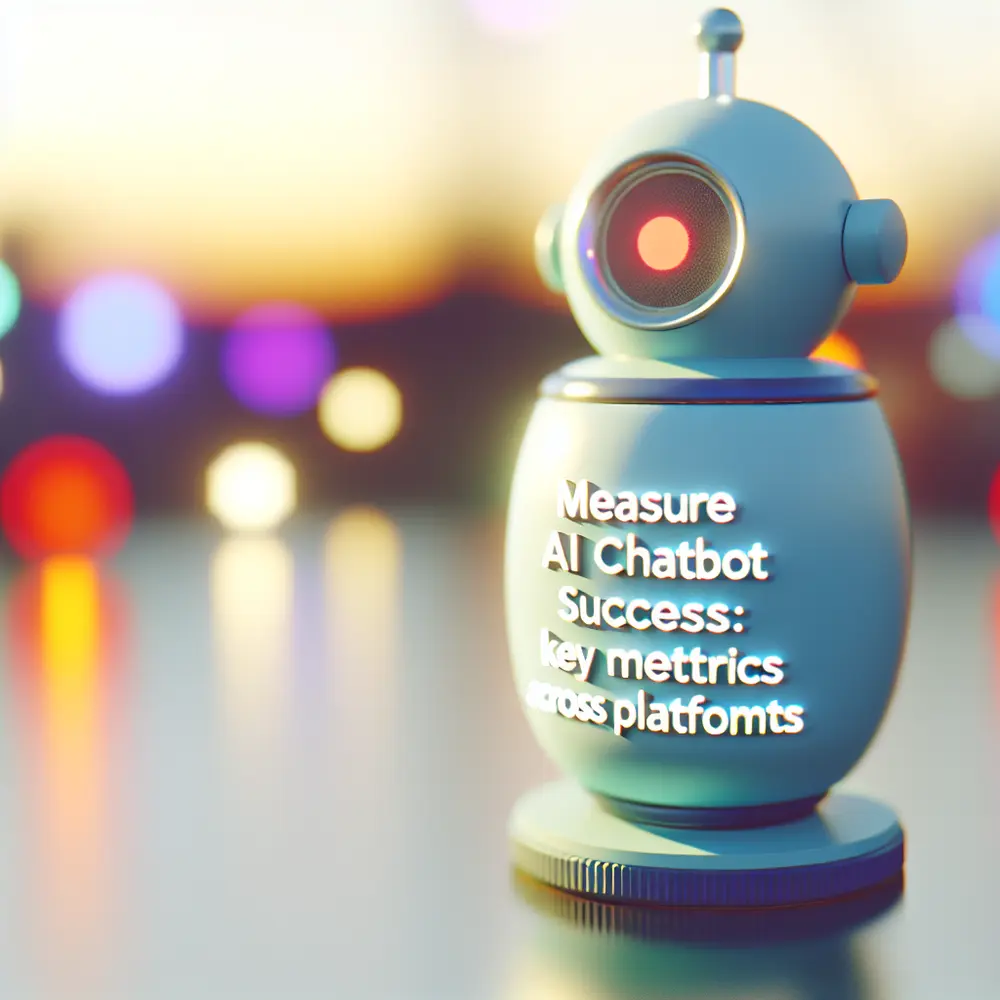Measuring the success of your AI chatbot is crucial for enhancing customer experience (CX) and streamlining communication. A deep understanding of essential metrics not only allows you to identify strengths and weaknesses but also to adapt strategies that drive improved engagement. In today’s competitive landscape, focusing on the right measurements is key to maximizing your chatbot’s potential.
Key metrics serve as benchmarks for evaluating chatbot effectiveness. Metrics such as user engagement rates, resolution times, and deflection rates provide insights into how well your chatbot performs. A high engagement rate indicates that users interact positively, while longer resolution times may signal design issues that need addressing. Explore the Customer Service Handbook: The Complete Guide to improve your chatbot strategies.
Analytics tools are fundamental for monitoring key performance indicators (KPIs). By leveraging platforms with robust analytic capabilities, you can track user interactions in real time, gaining insights that guide critical decision-making. Analyzing chat logs and user feedback highlights common pain points, leading to optimizations that enhance user satisfaction. To dive deeper into tools for analytics, visit How to Create a Automated Sales Bot on WhatsApp.
Understanding AI Chatbot Success: Why Measurement Matters
Embracing a strategic measurement framework ensures that you assess current performance and forecast future enhancements. By leveraging the data generated from key metrics, you can implement targeted improvements and anticipate user needs, ultimately leading to high customer satisfaction and loyalty.
For example, the “Retail Innovator” company utilized key metrics to evaluate its chatbot’s performance. By tracking engagement rates and resolution times, they identified a significant drop in customer satisfaction. Adjustments made based on these insights led to a 20% increase in successful interactions over three months. Understanding these metrics is essential for your improvement. Check the Benefits of a CRM Integrated with WhatsApp to see how businesses leverage chatbot statistics.
In conclusion, measuring AI chatbot success through comprehensive metrics and analytics isn’t just operational; it is strategic. By investing time and resources into understanding and applying these insights, your organization can turn its chatbot into a powerful tool for customer engagement and operational efficiency. Explore the Omnichannel Support Platform for seamless integration and enhancement of your chatbot’s effectiveness.
Key Metrics for Measuring AI Chatbot Performance
To effectively gauge AI chatbot success, you must focus on key metrics that reflect its contribution toward business goals. These metrics provide valuable insights into user engagement and help optimize the chatbot for enhanced customer experiences.
User Engagement Metrics
User engagement metrics are vital for chatbot performance. Monitor unique users, total interactions, and conversation lengths. A higher number of unique users signals effective outreach, while prolonged conversation lengths might indicate deeper engagement. For instance, “TravelTech,” an online travel agency, saw a 25% increase in unique user interactions after refining their engagement approach based on these metrics.
Response Accuracy and Resolution Rate
Evaluate response accuracy by determining the percentage of inquiries the chatbot resolves without human help. A high resolution rate reflects well on the chatbot’s capacity to manage user needs effectively. “HealthConnect” achieved a 30% improvement in resolution rates after addressing specific queries that were repeatedly escalated to human agents.
Customer Satisfaction Scores
Collect customer satisfaction (CSAT) scores through post-interaction surveys. These scores provide insights into user perceptions. Consistently high CSAT indicates the chatbot meets expectations, while low scores signal that further assessment is needed. “BankTrust” integrated CSAT surveys and subsequently improved their scores by 15% by fine-tuning conversational flows.
Conversion Metrics
Tracking conversion rates is essential to measuring chatbot success. Keep tabs on user actions taken post-interaction, like completing purchases or newsletter sign-ups. “E-Commerce Hub” reported a 20% increase in conversion rates after analyzing chatbot interactions and refining calls to action.
Continuous Improvement Through Analytics
Incorporate analytics tools for ongoing monitoring. These tools allow you to visualize metrics and trends, enabling swift adaptations to your chatbot’s functionality. “Service Solutions” fully integrated analytics and boosted chatbot engagement by 25% in just one quarter.
Analyzing Chatbot Analytics: Tools and Techniques
A comprehensive understanding of analytics tools is essential for effectively measuring AI chatbot success. Analyzing user interactions continuously allows for workflow optimization. For instance, integrating engagement and sentiment analysis enables companies to adapt chat capabilities significantly.
Engagement Rate Monitoring
Monitoring engagement rates signals how well users interact with the chatbot. For example, “Retail Dynamics” observed a correlation between session length and user satisfaction, prompting them to devise more engaging conversational flows.
Sentiment Analysis
Utilize sentiment analysis to gauge user emotions regarding interactions. Positive sentiment often correlates with successful conversations. “FoodService” applied sentiment analysis and observed a 20% increase in positive feedback, leading to actionable insights for improvement.
Omnichannel Performance Tracking
Implementing omnichannel strategies allows you to gather insights from multiple platforms. This holistic view improves decision-making. “CrossChannel Corp” enhanced user experiences significantly through omnichannel analytics, leading to a remarkable 30% increase in session retention.
Continuous Monitoring and A/B Testing
Conduct A/B testing on different conversation flows to refine user engagement continually. “Customer First” improved its engagement rates by 15% after implementing a system for regular testing and adjustment based on analytical insights.
Cross-Platform Performance: How AI Chatbots Measure Up
Measuring AI chatbot success across different platforms requires a thorough analysis of various key metrics. Understanding performance across multiple channels drives better engagement.
User Engagement and Retention
Evaluate active user rates and interaction counts to assess whether the bot retains user interest. For instance, “Digital Solutions” found that tracking user retention across channels highlighted areas for focused improvements, raising engagement rates by 25%.
Conversion Tracking
Monitor actions taken after chatbot interactions. High conversion rates reflect the chatbot’s ability to facilitate desired actions effectively. “ShopEasy” achieved a 25% increase in purchases through careful monitoring of conversion metrics.
Dropout Rates and Pain Points
Analyzing dropout rates provides insights into when users abandon conversations. This identification helps address functional issues. “TravelService” utilized dropout metrics to reduce abandonment rates by 20% through targeted enhancements.
Comparative Performance Analysis
Conduct comparative performance analysis across various platforms to inform tailored strategies. “Retailer Pro” improved response times by analyzing interactions on different channels, positioning itself as a leader in customer response speed.
Strategic Approaches to Optimize Your AI Chatbot Success
Focusing on key metrics beyond basic usage stats reveals gravitas in chatbot performance. Engagement metrics, conversion rates, and user satisfaction are vital for understanding AI chatbot impact on customer interactions.
Engagement Metrics
Monitor interaction rates to gauge user satisfaction. “TechLink” saw a remarkable 35% improvement in engagement after analyzing and enhancing interaction metrics.
Conversion Effectiveness
Track how well chatbots meet set goals like lead generation. “FinanceGroup” improved its lead conversion rates by 40% after aligning tracking analytics with chatbot interactions.
User Satisfaction Feedback
Utilize insights from user feedback to strengthen chatbot effectiveness. “CarePlus” fine-tuned responses based on CSAT metrics, resulting in a 20% increase in satisfaction scores.
Benchmarking Against Industry Standards
Compare performance metrics with competitors to inform growth strategies. “MarketLeader” improved customer engagement through insightful benchmarking analysis.
Case Studies: Real-World Applications of Chatbot Metrics
Understanding successful applications of chatbot metrics can guide businesses in enhancing customer experiences. These case studies exemplify how analytics drive strategic improvements.
Retail Example
A retail company’s integration of a chatbot revealed key metrics for conversation completion rates. Adjustments increased customer satisfaction by 15% through targeted enhancements.
Travel Industry Case
A leading airline identified high-resolution rates through careful metric tracking, which led to a 20% increase in successful bookings. This connection between performance analytics and outcomes provides a valuable template for other businesses.
Banking Context
A financial organization’s chatbot focused on user engagement metrics, resulting in a 30% growth in user interactions after improvements were made based on analysis.
Healthcare Scenario
A healthcare provider utilized appointment booking metrics, reducing wait times significantly and enhancing patient satisfaction through strategic adjustments.
Future Trends in AI Chatbot Analytics and Measurement
The rapidly evolving landscape of AI chatbot analytics highlights the need for effective measurement of chatbot success. Emerging trends point to more sophisticated metrics for deeper insights into chatbot performance.
Real-Time Analytics
Real-time analytics enable instant tracking of chatbot performance, paving the way for immediate adjustments. CX managers at “FastResponse” experienced a noticeable improvement in customer interactions due to this capability.
Multi-Channel Performance Metrics
Organizations recognize the importance of consistent chatbot performance across platforms. By integrating key metrics across channels, businesses ensure a unified customer experience.
Predictive Analytics
Predictive analytics leverage historical data to enhance chatbot interactions, leading to improved relevancy and timeliness, as observed by “Predictive Solutions,” who saw a 25% increase in user engagement.
Personalization Trends
Increasing personalization in chatbot interactions requires advanced measurement strategies. Tailoring responses based on user preferences has become essential for maximizing engagement.
Conclusion: Turning Metrics into Action
Measuring AI chatbot success involves more than tracking metrics; it’s about transforming data into actionable insights that drive business decisions. Understanding key metrics enables you to refine chatbots, enhance customer interactions, and strengthen overall CX.
Customer satisfaction (CSAT) should be a focal point. Analyzing CSAT provides immediate feedback for chatbot improvements. Engagement and performance metrics also play a vital role in comprehensive assessments, as understanding these trends leads to strategic adjustments.
Lastly, continually refining chatbot implementations through systematic analysis enhances customer experiences. Embracing a data-driven mindset empowers you to make decisions that drive your company forward. For robust solutions that support this strategic approach, consider integrating an Omnichannel Support Platform to serve your customers effectively.









